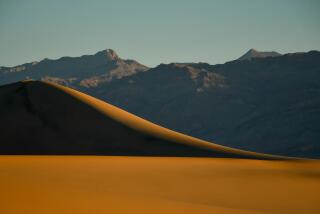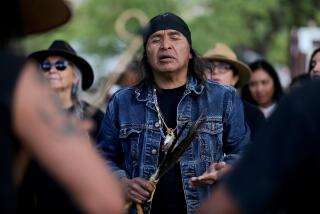Mining claims could mar national park and wilderness area borders, report says
Mining claims threaten to mar the borders of 10 iconic national parks and wilderness areas, particularly the Grand Canyon, where uranium claims have increased 2,000% since 2004, according to a new report by the Pew Environment Group.
Mining companies have filed claims to the rights to copper, gold and other metals in addition to uranium in areas around Mt. Rushmore, Joshua Tree National Park and other famous refuges at an increased rate in the last five to seven years because of rising global prices, the Pew report said.
Claims in such sensitive places are facilitated by an outmoded 1872 law, critics say. The law allows corporations to stake out rights to federal lands for mining without a competitive bid and to extract resources without paying royalties.
“The 1872 law as it applies everywhere is carte blanche: You extract everything you can and don’t pay royalties on it,” said Rep. Raul M. Grijalva (D-Ariz.). “We’re still dealing with an antiquated law that in its wake has left huge cleanup and contamination problems all over.”
Concerns about the boom in uranium claims near the Grand Canyon prompted the Obama administration in 2009 to withdraw 1 million acres from further staking of claims for two years. Now the administration is weighing a 20-year extension of that withdrawal.
But mining on existing claims around the Grand Canyon would go forward, and territory neighboring other parks remains open to more claims and mining.
Although the pace of claims has slowed recently, there are about 3,500 uranium claims around the canyon, according to Pew and the federal Bureau of Land Management. About 50 of the claims are being actively mined, said Rody Cox, a geologist with the bureau’s Arizona Strip district office.
Uranium mining in the Southwest has a history of contamination. The Metropolitan Water District of Los Angeles and the Southern Nevada Water Authority have voiced concerns about possible damage to the Colorado River watershed, which could affect as many as 25 million people, if uranium mining occurs around the Grand Canyon.
The Environmental Protection Agency has said removing contamination that stems from hard-rock mining could be among the greatest costs to the Superfund program for cleaning up toxic sites.
Compared with the Grand Canyon, claims near other parks are fewer, the Pew report noted, but they are climbing. For example, about 950 claims have reportedly been made within five miles of the boundaries of Arches and Canyonlands national parks in Utah, nearly all since 2005.
Environmentalists and some politicians have long pushed Congress to amend the 1872 law to include a competitive bid process and royalty payments, without success.
Reform seems just as unlikely now. The Republican-controlled House is committed to protecting industry in general, and the Senate is led by Majority Leader Harry Reid (D-Nev.), whose state includes vast gold mines. The powerful National Mining Assn. opposes competitive bids and royalties on gross proceeds from mineral sales.
To stake a claim, one merely has to fill out paperwork at a BLM office and with the county government and pay a $140 fee. Companies must undergo an environmental assessment to get a BLM permit to mine, but they pay no royalties on the proceeds of their sales. In contrast, oil and gas companies pay gross royalties of 12.5% for onshore production, and coal concerns with federal underground mine leases pay 8%.







